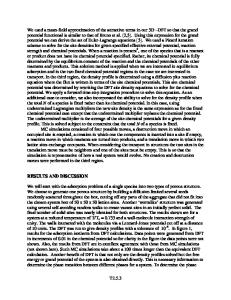Molecular Modeling of the Dielectric Saturation in Proton Exchange Membranes
- PDF / 67,380 Bytes
- 6 Pages / 612 x 792 pts (letter) Page_size
- 59 Downloads / 356 Views
Molecular Modeling of the Dielectric Saturation in Proton Exchange Membranes Reginald Paul1 and Stephen J. Paddison2 1 Chemistry Department, The University of Calgary, Canada T2N 1N4 2 Computational Materials Group, Motorola Inc., Los Alamos Research Park, Los Alamos, NM 87544 ABSTRACT A molecular statistical mechanical method is employed to compute the field dependant permittivity of water contained in the hydrophilic pores of hydrated proton exchange membranes. The anionic ( − SO 3− ) groups in proximity to the pore walls generate spatially varying fields resulting in dielectric saturation, the effects of which are investigated. INTRODUCTION Polymer electrolyte membrane fuel cells (PEMFCs) employ ionomeric polymers as their electrolytes (e.g. the sulfonic acid based Nafion®, PEEKK, etc). The anodic reaction involves the oxidation of hydrogen (H2(g), CH3OH(aq), etc.) resulting in the production of protons, while the cathodic reaction involves the reduction of the protons in the presence of oxygen [1]. In the presence of water, these polymers nano-separate into hydrophobic and hydrophilic domains; the latter being responsible for the proton conductivity, an important parameter linked to the performance of the fuel cell. In addition to water and protons, the hydrophilic domains or pores also contain the dissociated sulfonic acid fixed sites [2-4]. The interaction of these groups ( − SO 3− ) with the hydrated protons is a dominant factor affecting the mobility of the protons. In order to understand and describe the factors determining the conductivity of the membrane, a molecular framework becomes indispensable. Paddison, et al [5,6] derived a molecular transport model that computes the diffusion coefficient of a hydronium ion using non-equilibrium statistical mechanics. Both the agreement with experiment, and the predictive powers of this model are well attested. However, in writing the various interaction potentials that are present in the Hamiltonian, it was tacitly assumed that the permittivity could be ascribed a value equal to that of bulk water. Assuming a cylindrical shape for the pores, it is evident from very simple qualitative considerations, that protons closest to the center of the pore will be the main carriers of current. These protons, being remotely located from the fixed groups, will possess the maximum mobility and therefore the assumption of a bulk value for the permittivity in this region is reasonable. The question still remains, however: How far can one move away from the pore center and still expect the permittivity to remain unchanged? In order to answer this question, we have developed a molecular theory for the pore permittivity. THEORY We consider a collection of N water molecules, in a pore of length L and cross sectional radius R , where the pore walls carry the negatively charged sulfonate groups. Each molecule of water is assumed to posses a dipole moment µ . From standard electrostatics [7] the AA7.16.1
permittivity, as a function, of the pendant group field, E , can be related to th
Data Loading...











